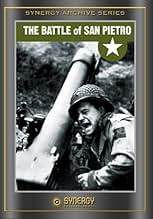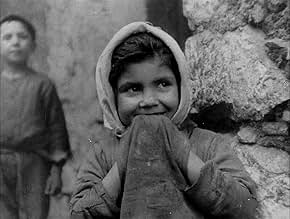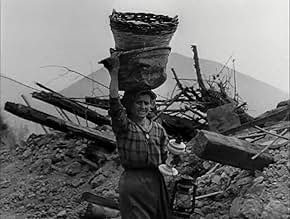NOTE IMDb
6,6/10
2,6 k
MA NOTE
Ajouter une intrigue dans votre langueDirector John Huston documents the Battle of San Pietro Infine in December 1943.Director John Huston documents the Battle of San Pietro Infine in December 1943.Director John Huston documents the Battle of San Pietro Infine in December 1943.
- Réalisation
- Scénario
- Casting principal
- Récompenses
- 1 victoire au total
Mark W. Clark
- Self - Introduction
- (non crédité)
John Huston
- Narrator
- (voix)
- (non crédité)
Avis à la une
10marie_D
This film is available on DVD -- as part of the "Treasures from American Film Archives" collection released this year. The collection has lots of gems on its four disks but "The Battle of San Pietro" alone would make it worth the price.
I watched this 30-minute documentary of one of many battles in Italy shortly after having viewed "All Quiet on the Western Front" for the first time. I thought the Milestone film was brilliant but it was this Huston documentary that made me cry. I don't know whether it is the matter-of-fact narration (by the director), the sight of all those G.I.s, or the Italian children that got to me but the sum of it all was almost overwhelming. Very highly recommended. 10/10
I watched this 30-minute documentary of one of many battles in Italy shortly after having viewed "All Quiet on the Western Front" for the first time. I thought the Milestone film was brilliant but it was this Huston documentary that made me cry. I don't know whether it is the matter-of-fact narration (by the director), the sight of all those G.I.s, or the Italian children that got to me but the sum of it all was almost overwhelming. Very highly recommended. 10/10
John Huston's World War II documentary on the battle of San Pietro is easily up to the high standard that he set with his numerous classic dramas. It is impressive in describing both the events and the atmosphere of a desperate and costly struggle, and it is memorable in preserving its effect on those who had to live through it.
Even on a purely historical level, this would serve as a valuable description of one stage in the grueling Italian campaign, one of the war's least-remembered and least glamorous aspects. The narration is very efficient in detailing what the battle was about, what happened, and why it happened. It puts everything into the perspective of the war as a whole, and it also provides a look at the nature of the Allies' slow, grueling, costly progress up the Italian peninsula.
On a dramatic level, it is even more effective and memorable. Without forcing anything, without resorting to ploys of any kind, it brings you into the world of the unfortunate foot soldiers on whose backs and blood the fate of the battle rested. Huston's narration is flawless, using evenly measured tones to describe events in such a way as to allow them and the pictures of them to speak for themselves - and they speak in a powerful way.
Most of the footage must have been taken at considerable risk, and while there is nothing fancy about the techniques, it's impressive how much it captures. The soldiers slowly crawling along rocky heights, the pounding of heavy artillery, the frightened civilians hiding in caves, and much more, are all vividly captured. It's hard to think of another documentary then or now that succeeds so well at what it set out to do.
Even on a purely historical level, this would serve as a valuable description of one stage in the grueling Italian campaign, one of the war's least-remembered and least glamorous aspects. The narration is very efficient in detailing what the battle was about, what happened, and why it happened. It puts everything into the perspective of the war as a whole, and it also provides a look at the nature of the Allies' slow, grueling, costly progress up the Italian peninsula.
On a dramatic level, it is even more effective and memorable. Without forcing anything, without resorting to ploys of any kind, it brings you into the world of the unfortunate foot soldiers on whose backs and blood the fate of the battle rested. Huston's narration is flawless, using evenly measured tones to describe events in such a way as to allow them and the pictures of them to speak for themselves - and they speak in a powerful way.
Most of the footage must have been taken at considerable risk, and while there is nothing fancy about the techniques, it's impressive how much it captures. The soldiers slowly crawling along rocky heights, the pounding of heavy artillery, the frightened civilians hiding in caves, and much more, are all vividly captured. It's hard to think of another documentary then or now that succeeds so well at what it set out to do.
I saw this film while watching my copy of the 4-DVD set "Treasures From American Film Archives"--a set of mostly ephemeral films that would have otherwise been lost.
"San Pietro" is a film assembled by the US War Department to chronicle one of many battles from WWII. Like so many government films made during WWII, it is narrated by a Hollywood star (director John Huston) and I assume it was made by film makers who were in military service for the war.
The film's narration and images are surprisingly blunt and free from extreme patriotism--making it highly realistic and gripping. In other words, the film is not all about American victory but shows casualties and describes how difficult this battle was--not some jingoistic rant meant to glorify war and make it seem like the troops were super-human. While some might have thought this would demoralize the folks at home (hence it was held for release for two years), it was direct, informative and well-constructed. At times, it felt almost as if you were there in the action and was very compelling--and a nice tribute to real sacrifices made by some very brave soldiers as well as an important historical record.
"San Pietro" is a film assembled by the US War Department to chronicle one of many battles from WWII. Like so many government films made during WWII, it is narrated by a Hollywood star (director John Huston) and I assume it was made by film makers who were in military service for the war.
The film's narration and images are surprisingly blunt and free from extreme patriotism--making it highly realistic and gripping. In other words, the film is not all about American victory but shows casualties and describes how difficult this battle was--not some jingoistic rant meant to glorify war and make it seem like the troops were super-human. While some might have thought this would demoralize the folks at home (hence it was held for release for two years), it was direct, informative and well-constructed. At times, it felt almost as if you were there in the action and was very compelling--and a nice tribute to real sacrifices made by some very brave soldiers as well as an important historical record.
i recently saw the approx. 40min version of this film and i must say, knowing what is missing from the 32min version, that it is indeed far more impactful and superior. images of more fallen soldiers in white body bags appear and reappear throughout to the point of it being a reocurring theme. i'm sure it's just as brilliant without the extra footage, but if you can, try to see the extra footage. while i have not seen the true original (running approx. 50min), i'm quite positive it's even better than the one i was fortunate enough to see. a great documentary film all-around (even if some of it was staged).
One reviewer commented that he didn't know how this film ever got released during World War II. It almost didn't.
First, you need to know that Hollywood actors, directors and producers were heavily recruited by the War and Navy Departments (the Defense Dept. is a post war innovation). These celebrities got to know a lot of the senior military personnel through their activities in Stage Door Canteens, the USO, recruiting and bond drives. Few were closer to the military top brass than Orson Welles, a close friend of Houston's.
Welles told this story on, I believe, a Dick Cavett Show in the late 1960s or very early 1970s. I repeat it as I remember it.
According to Welles the War Department censors did not want San Pietro released. They felt that the film was too graphic and that it might have an adverse effect on support for the war. Through Welles' personal friendship with General George C. Marshall he and Houston arranged a private screening at the Pentagon for Marshall, his staff and the censors. Following the screening Gen. Marshall stood up and ordered that the film be released. He said that it was an accurate depiction and that war was horrible. He felt that the American people needed to know that horror lest they romanticize war and become fond of a monstrous act of inhumanity.
So San Pietro was released. If Welles exaggerated his role, I can't say. Certainly Houston didn't contradict him. If I have misremembered the tale in some particular, it does not change the fact that San Pietro owed its release to the intervention of Marshall.
Even today San Pietro is worth seeing. As has already been suggested, it is a good complement to Lewis Milestone's All Quiet on the Western Front. I would suggest that it also ranks with two other great movies whose subject is World War I. Those movies are Jean Renoir's Grand Illusion and Stanley Kubrick's Paths of Glory. And, although it doesn't quiet rank with the three films already mentioned, Philippe de Broca's King of Hearts belongs in the insanity of war film festival we seem to be constructing here. Finally, I would point out that earlier wars are often stand ins for the more recent one as in M.A.S.H. Korea stood in for Vietnam.
First, you need to know that Hollywood actors, directors and producers were heavily recruited by the War and Navy Departments (the Defense Dept. is a post war innovation). These celebrities got to know a lot of the senior military personnel through their activities in Stage Door Canteens, the USO, recruiting and bond drives. Few were closer to the military top brass than Orson Welles, a close friend of Houston's.
Welles told this story on, I believe, a Dick Cavett Show in the late 1960s or very early 1970s. I repeat it as I remember it.
According to Welles the War Department censors did not want San Pietro released. They felt that the film was too graphic and that it might have an adverse effect on support for the war. Through Welles' personal friendship with General George C. Marshall he and Houston arranged a private screening at the Pentagon for Marshall, his staff and the censors. Following the screening Gen. Marshall stood up and ordered that the film be released. He said that it was an accurate depiction and that war was horrible. He felt that the American people needed to know that horror lest they romanticize war and become fond of a monstrous act of inhumanity.
So San Pietro was released. If Welles exaggerated his role, I can't say. Certainly Houston didn't contradict him. If I have misremembered the tale in some particular, it does not change the fact that San Pietro owed its release to the intervention of Marshall.
Even today San Pietro is worth seeing. As has already been suggested, it is a good complement to Lewis Milestone's All Quiet on the Western Front. I would suggest that it also ranks with two other great movies whose subject is World War I. Those movies are Jean Renoir's Grand Illusion and Stanley Kubrick's Paths of Glory. And, although it doesn't quiet rank with the three films already mentioned, Philippe de Broca's King of Hearts belongs in the insanity of war film festival we seem to be constructing here. Finally, I would point out that earlier wars are often stand ins for the more recent one as in M.A.S.H. Korea stood in for Vietnam.
Le saviez-vous
- AnecdotesThis film was considered so blunt in its depiction of the difficulties of the battle that the US Army refused to show it, believing it to be damaging to troop morale.
- ConnexionsEdited into Les Forçats de la gloire (1945)
Meilleurs choix
Connectez-vous pour évaluer et suivre la liste de favoris afin de recevoir des recommandations personnalisées
Détails
- Durée32 minutes
- Couleur
- Mixage
- Rapport de forme
- 1.37 : 1
Contribuer à cette page
Suggérer une modification ou ajouter du contenu manquant

Lacune principale
By what name was La bataille de San Pietro (1945) officially released in India in English?
Répondre





















